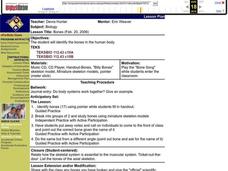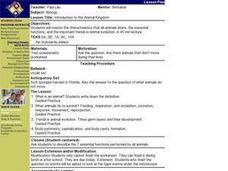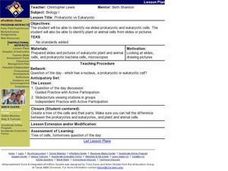Curated OER
Third Grade Geometry
Third graders describe 2D and 3D shapes. In this geometry lesson, 3rd graders watch a PowerPoint presentation showing the terms used when analyzing shapes: vertex, edge, angle, side, and face. They compare shapes to see what they have in...
Curated OER
Transformation
Students discover visual arts by participating in a sculpting activity. In this artistic expression lesson, students examine some of the more famous sculptures in world history by utilizing the Internet. Students utilize clay, paper...
Curated OER
Special Accommodations
This accommodations template provides a checklist of special accommodations that may be required for special needs learners in six areas: attention, academic, behavior, testing, speech/language, and OT/PT. Space is also provided for...
Curated OER
Writing Topics
Finding a topic that engages young writers can be difficult. The four prompts offered by this resource focus on pets. Whether it be writing a story about an imaginary pet or about preparing for a pet, your pupils will find something here...
Curated OER
Warm/cool Colors - Page 4
Students draw pictures that make them feel either warm or cool using only the warm and cool colors.
Curated OER
Safety in the Biology laboratory
Students review safety in the biology laboratory. They summarize the rules and safety procedures by completing several activities such as practice questions, taking notes andbecoming familiar with the location of safety equipment.
Curated OER
Reaction rates and Equilibrium
Students listen to a lecture on the collision theory. They discuss the reactant and product changes during a chemical reaction. Students are taught the factors affecting reaction rates. They complete a lab on entropy, heat and free...
Curated OER
Structure of the Atom
Students identify the location and change of the subatomic particles of an atom. They name the three subatomic particles. Students review what they can recall about subatomic particles. They are given a worksheet on the subatomic...
Curated OER
Protists: animallike Protists
Pupils are taught that Malaria and African Sleeping sickness are caused by protists. They discuss how animal-like protists harm other living things. Students discuss and listen to the major phyla of animallike protists. They draw and...
Curated OER
Congress of Vienna
High schoolers label and locate the 5 European Powers of the congress of Vienna on a map. They describe the goals of the Congress of Vienna by completing a web diagram. Students identify and explain the legacy of the congress of Vienna...
Curated OER
IPC Review
Students discuss the difference between atoms and elements. They analyze how compounds are formed. Students discuss the difference between covalent bonds, hydrogen bonds, and ionic bonds. They review bonding with diagrams, "Atoms or...
Curated OER
Energy in Living Systems
Students are asked: Is our life's purpose over when it's over? What happens to our bodies? They analyze the flow of energy through living systems. Students compare the metabolism of autotrophs with that of heterotrophs. They create a...
Curated OER
Monocots vs. Dicots
Learners examine the differences in nonvascular and vascular plants. They compare the differences between gymnosperm and angiosperms. Students compare the differences between moocots and dicots. They view a powerpoint presentation on...
Curated OER
Bones
Students listen to the song "Bone Song" as they enter the class. They identify the bones in the human body. Students are given the topic: Do body systems work together? Give an example. They work in groups of two and study the bones...
Curated OER
The Heart
Students explore the structures in the heart and follow the path of blood through the heart and lung. They copy the Fill-in-the blank notes from the colored folders that are located at the stations throught the room. Students are...
Curated OER
Circulatory and Respiratory Systems
Learners are taken to a shady location and they seat in a large circle. They are given three questions each. Students research and answer the three questions. They summarize the circulatory and respiratory system and relate how they...
Curated OER
Review of the Scientific Method
Young scholars review the Scientific Method with a hands-on activity. Working with a partner, they hypothesize the number of water drops that fit on the heads side of a penny. They collect data and share their results with the...
Curated OER
Introduction to the Animal Kingdom
Learners are asked: Are there animals that don't move during their lives. They are asked what is an animal? Students discuss what animals need to survive. They are taught the trends in animal evolution. Learners discuss the three...
Curated OER
Meiosis Lab: Building Baby Reebops
Students review the following vocabulary: Independent assortment, multiple alleles, and polygenic traits. They review their vocabulary by the "quiz, quiz trade" routine. Students work in groups. They are given one set of gene cards...
Curated OER
Type of Chemical Reactions: Single and double displacements
Students are taught that combustion of carbon in charcoal briquetts produces heat and light. They are shown how to find single displacement and double displacement. Students solve problem set of single and double displacement.
Curated OER
Photosynthesis: Light-dependent and Calvin cycle
Students recognize the concepts of the light-dependent and the Calvin cycles. They draw diagrams of the light-dependent reaction and the Calvin cycle. In addition, they investigate the effects of light on carbohydrate content in leaves.
Curated OER
Diversity of Protists
Learners identify under a microscope several different genera of protists. They discuss the three different categories of protists. Students discuss characteristics of the protists that they have already been taught. They view and...
Curated OER
Geologic Time Scale
Young scholars recreate and comprehend the geologic time scale. They discuss how long humans have been around on Earth. Students are shown the geologic time scale and its different parts. They work in groups to recreate the time scale.
Curated OER
Prokaryotic vs Eukaryotic
Students identify via slides prokaryotic and eukaryotic cells. They identify plant or animal cells from slides or pictures. Students are given the question of the day. They are asked which has a nucleus, a prokaryotic or eukaryotic...























